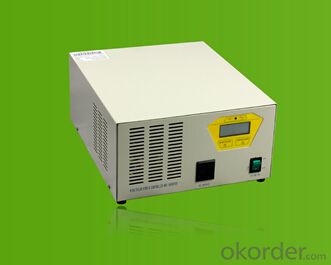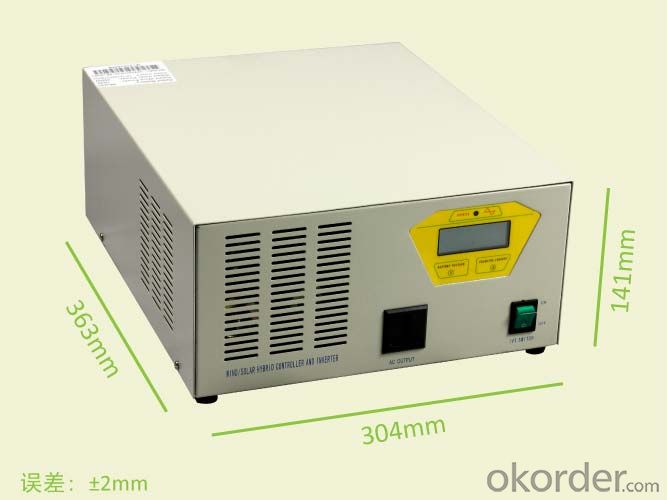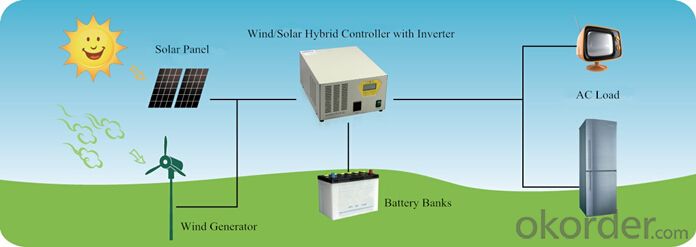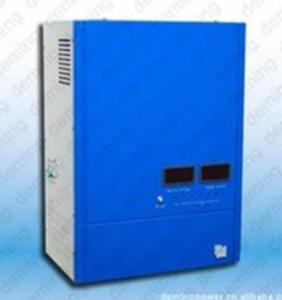Wind Solar Hybrid Controller with Inverter - Solar Controllers from Italy Supplier
- Loading Port:
- Shanghai
- Payment Terms:
- TT or LC
- Min Order Qty:
- 1 unit
- Supply Capability:
- 8000 unit/month
OKorder Service Pledge
OKorder Financial Service
You Might Also Like
I. PRODUCT INTRODUCTION
Wind/solar hybrid controller with inverter is the intelligent power supply with integration of wind/solar control and DC to AC inverse. The apparatus is mainly used for wind /solar renewable energy power system; provide effective power supply for traffic inconvenience, harsh environment of mountain area, a pasturing area, border, islands and other areas without electricity. With decent appearance, easy operation, and visual indication of LCD, the controller has perfect protection function, high charging efficiency and low no-load loss.
II. PERFORMANCE FEATURES
Perfect protection function, thus the system has higher reliability.
LCD display function, visually display battery voltage and charge current.
Integrated design of controller and inverter, with simple and easy maintenance.
PWM stepless unload mode, which burn excess power into dump load, making the battery charging in the best status.
Power frequency toroidal transformer, ensures inverter has high efficiency and low no-load loss.
Pure sine wave output, compared with square wave or modified wave, has higher efficiency and higher capability of driving load.
Certificate for Invention Patent of wind/solar hybrid controller with inverter, European CE.
III. APPLICATION AREAS
Domestic household wind power and photovoltaic power system, wind power station and photovoltaic power station.
Coastal islands, remote mountainous, border posts for regions shortage of or without electricity.
Government demonstration projects, landscape lighting project.
Mobile communication base station, expressway and other non-residential regions.
IV. 300W-500W TECHNICAL PARAMETERS
Product Model | WWSI0303-12 | WWSI0303-24 | WWSI0505-12 | WWSI0505-24 |
Rated wind turbine power | 300 W | 300 W | 500 W | 500 W |
Rated solar panel power | 90 W | 90 W | 150 W | 150 W |
Floating charging voltage | 14.5 V | 29 V | 14.5 V | 29 V |
Dump load current | 25 A | 13 A | 42 A | 21 A |
Rated inverter output capacity | 300 VA | 300 VA | 500 VA | 500 VA |
12 V | 24 V | 12 V | 24 V | |
Over voltage shutoff | 17 V | 34 V | 17 V | 34 V |
Over voltage recovery | 16.5 V | 33 V | 16.5 V | 33 V |
Battery over-discharge shutoff | 10.8 V | 21.6 V | 10.8 V | 21.6 V |
Battery over-discharge recovery | 12 V | 24 V | 12 V | 24 V |
No-load loss current | ≤0.9 A | ≤0.4 A | ≤1 A | ≤0.5 A |
Net weight | 9 kg | 9 kg | 11 kg | 11 kg |
Dimension | 370×300×130 mm | |||
Output wave | pure sine wave | |||
Display mode | LCD | |||
Cooling | Fan | |||
Rated output power | 110/120/220/230/240 VAC | |||
Wave distortion | ≤4% | |||
Output frequency | 50/60±0.5 Hz | |||
Dynamic response | 5% | |||
Power factor | ≥0.8 | |||
Over-load capacity | 120% 1min, 150% 10s | |||
Inverter efficiency | maximum 90% | |||
Isolating mode | frequency toroidal transformer | |||
Protection level | ||||
Noise (1 meter) | ≤40dB | |||
Insulating strength | 1500VAC,1min | |||
Protection function | Battery over-charge protection; battery over-discharge protection; battery reverse connection protection; output overload protection; output short circuit protection; overheating protection; solar reverse charge protection; solar reverse connection protection; automatic brake and manual brake protection; lighting protection | |||
Working temperature | -20~+55℃ | |||
Ambient humidity | ||||
Working altitude | ≤4000m | |||
In order to serve our customers better. Our company can adjust parameters configuration according to customer’s requirement. | ||||
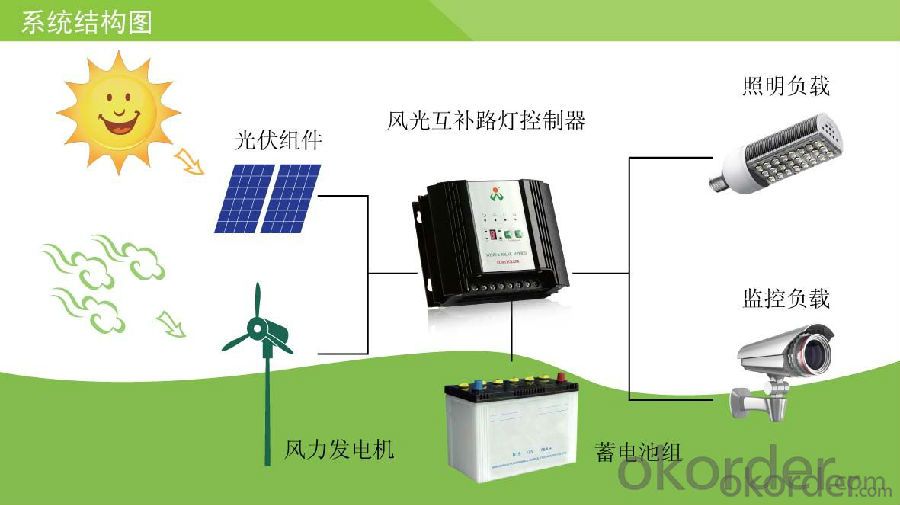
- Q: What is the purpose of the low voltage disconnect feature on a solar controller?
- In order to safeguard the batteries from over-discharge, the low voltage disconnect feature on a solar controller serves a crucial purpose. When the battery's voltage drops below a certain level, irreversible damage can occur, significantly reducing its lifespan. By monitoring the battery voltage, the low voltage disconnect feature effectively disconnects any load, such as appliances or devices, from the battery once the voltage falls below a predetermined threshold. This action prevents excessive drainage of the battery, ensuring that it retains a sufficient charge for proper functioning and longevity. Consequently, by disconnecting the load, the low voltage disconnect feature plays a vital role in protecting and optimizing the battery's performance within a solar power system.
- Q: What is the maximum temperature a solar controller can withstand?
- The maximum temperature a solar controller can typically withstand varies depending on the specific model and manufacturer. However, most high-quality solar controllers are designed to withstand temperatures up to 60-70 degrees Celsius (140-158 degrees Fahrenheit).
- Q: What is the role of a display screen in a solar controller?
- The role of a display screen in a solar controller is to provide visual information and user interface for monitoring and controlling the system. It allows users to view real-time data such as solar panel output, battery charge level, and system status. The display screen also enables users to adjust settings, set timers, and troubleshoot any issues that may arise. Overall, it enhances the user experience and facilitates efficient management of the solar power system.
- Q: Can a solar controller be used with a solar-powered air conditioning system?
- Yes, a solar controller can be used with a solar-powered air conditioning system. A solar controller helps to regulate and optimize the energy flow from the solar panels to the air conditioning system, ensuring efficient operation and maximum utilization of solar power.
- Q: Can a solar controller be used with a solar water pumping system?
- Yes, a solar controller can be used with a solar water pumping system. A solar controller helps regulate and control the power output from the solar panels to the pump, ensuring efficient operation and protection against overcharging or damage to the system. It helps optimize the performance of the solar water pumping system by managing the flow of electricity and protecting the batteries, allowing for reliable and sustainable water pumping.
- Q: Can a solar controller be used with different types of solar panel cooling systems?
- Yes, a solar controller can be used with different types of solar panel cooling systems. The solar controller regulates and monitors the charging process of the solar panel system, regardless of the cooling method employed. It ensures optimum performance and efficiency by managing the power flow and protecting the batteries from overcharging or undercharging, regardless of the cooling system in use.
- Q: Can a solar controller be used with a solar-powered electric fence energizer?
- Yes, a solar controller can be used with a solar-powered electric fence energizer. The solar controller helps regulate and optimize the charging of batteries used in the electric fence energizer, ensuring efficient operation and extending battery life.
- Q: Can a solar controller be used with solar-powered refrigeration systems?
- Yes, a solar controller can be used with solar-powered refrigeration systems. A solar controller is a device that regulates the voltage and current coming from solar panels to ensure the efficient charging and discharging of batteries. It helps to maximize the performance of the solar panels and protect the batteries from overcharging or discharging. In a solar-powered refrigeration system, the solar controller can be used to manage the power flow from the solar panels to the batteries that store the energy. It ensures that the batteries are charged properly during daylight hours and that the refrigeration system operates efficiently when the sun is not shining. By using a solar controller, solar-powered refrigeration systems can effectively harness solar energy and provide reliable cooling without relying on the grid or fossil fuels.
- Q: Can a solar controller be used with different battery chemistries?
- Yes, a solar controller can be used with different battery chemistries as long as the controller supports the specific requirements and charging profiles of those batteries. It is important to ensure compatibility and adjust the controller settings accordingly to optimize charging efficiency and prolong battery life.
- Q: What is the role of a solar controller in preventing damage to the solar panels from hail or storm events?
- The primary function of a solar controller is to act as a protective mechanism, preventing damage to solar panels from hail or storm events. Hailstorms and severe storms pose significant risks to solar panels, but a solar controller plays a vital role in mitigating these risks. To begin with, the solar controller is responsible for monitoring weather conditions. It analyzes data from various sensors and weather forecasting systems to detect the approach of a hailstorm or severe storm. This early detection enables the solar controller to take precautionary measures before the storm arrives. Once a storm is detected, the solar controller can activate protective mechanisms to safeguard the solar panels. One such mechanism is the automatic tilting of the panels to minimize the surface area exposed to hail or storm winds. This adjustment reduces the chances of direct impact from hailstones or debris, effectively preventing potential damage. In addition, solar controllers often incorporate sensors that can detect the impact of hailstones on the panels. If a certain level of impact is detected, the controller can automatically shut down the panels to prevent further damage. This feature is crucial as it reduces the risk of electrical surges or short circuits during a storm. Furthermore, solar controllers can activate protective coverings or shields to physically shield the panels from hail or storm-induced damage. These coverings are typically made of durable materials capable of withstanding the impact of hailstones or debris, providing an additional layer of protection to the panels. Overall, the role of a solar controller in preventing damage to solar panels from hail or storm events involves monitoring weather conditions, initiating precautionary measures, adjusting panel angles, shutting down panels if necessary, and providing physical protection. By fulfilling these functions, solar controllers play a critical role in ensuring the durability and efficiency of solar panel systems during adverse weather conditions.
Send your message to us
Wind Solar Hybrid Controller with Inverter - Solar Controllers from Italy Supplier
- Loading Port:
- Shanghai
- Payment Terms:
- TT or LC
- Min Order Qty:
- 1 unit
- Supply Capability:
- 8000 unit/month
OKorder Service Pledge
OKorder Financial Service
Similar products
Hot products
Hot Searches
Related keywords



